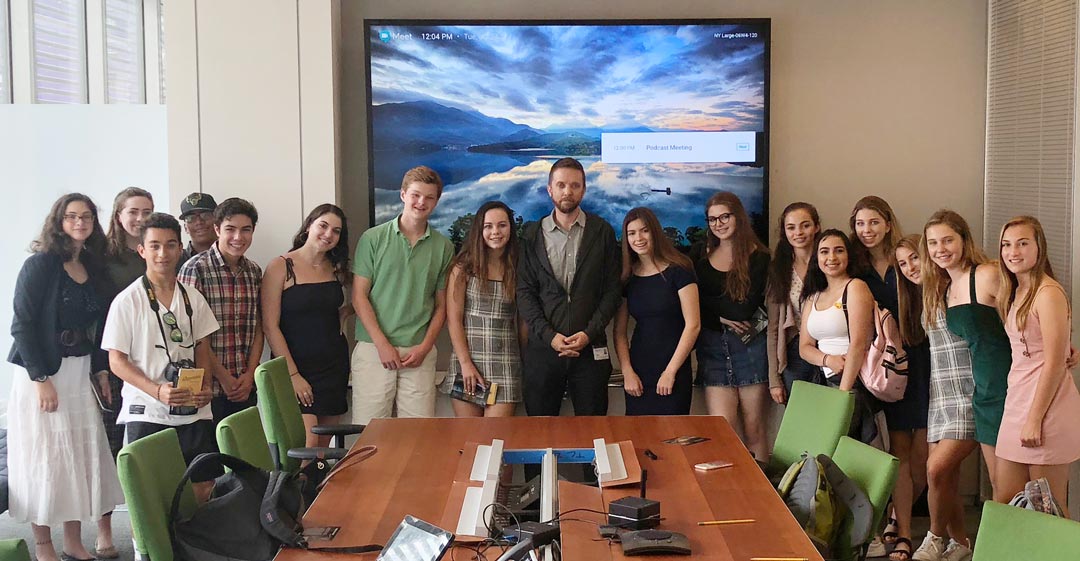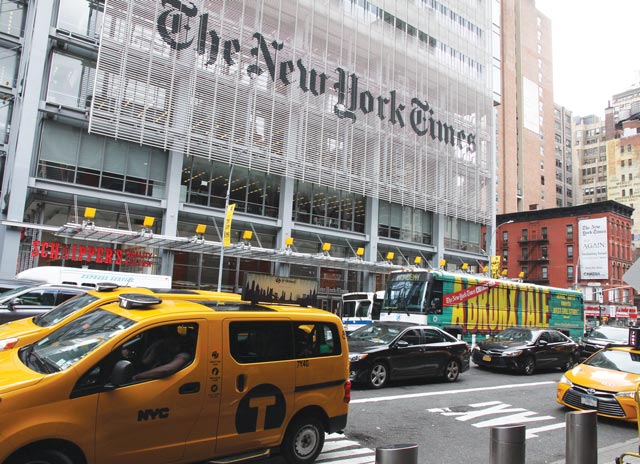ON LOCATION - December, 2018
The New York Times
Telling the Truth: One frame at a Time
WRITERS: C.C. Clark, Sabine Lloyd and Kyle Austin
REPORTERS: Lily Baldwin, Kylar Flynn, Brandon Lopez, Simone Harper, Angie Gonzalez, Jacqui Martin, Lauren McKechnie, Claire McKechnie, Samantha Michaels, Josh Santos, Anna Silverman, Campbell Slavin and Lilli Wanninger. (FROM: Community School, Drew, Redwood High, Marin Academy, San Rafael High, St. Ignatius Preparatory, Tamalpais High and University High Schools)
It’s easy to spot somebody who’s in love with their job. When they start to talk about whatever line of business it is they’re in, a spark appears in their eye and they enjoy telling you about the amazing things they get to do every day. When we met Andrew Blackwell, the supervising editor of the Op-Docs section of the New York Times and author of the book Visit Sunny Chernobyl, it was clear from the get-go that he’s one of those people. Throughout our interview at the Times Tower in Midtown Manhattan, he shared stories about his job in a breathless, almost zealous manner, like he wanted us to know everything about what he does so that we, too, would come to appreciate the beauty and relevance of (in his case) the creation and editing of acclaimed online documentaries. By the end of the interview, we did.

Op-Docs are short, interactive, often mind-blowing documentaries offered across the Times’ online platforms. They’re found in the opinion section, which is where contributors can be more creative and reflect their own biases and content isn’t as rigidly impartial as in the news section. “We like to say that every Op-Doc provokes a conversation among the audience,” said Blackwell, “which to me is just a way of saying we want every film to make people think or give someone an incredible emotional experience, or an incredible creative experience, or convince them or challenge something about how they think.”
As the supervising editor of Op-Docs, Blackwell’s primary role is working with outside contributors. “We don’t actually produce the Op-Docs,” he explained, “[we try] to find independent filmmakers that are making cool stuff and sort of incorporate them into our series.” To do so he keeps up to date on film festivals and other events that show documentaries, but several Op-Docs turn up as submissions. And when one arrives in finished form, all the Times has to do is publish it, giving it a much larger audience than it had before.
Combing through those submissions for hidden gold is one of the most important aspects of Blackwell’s job. “It’s like part of you is worried about turning down the Beatles because you just don’t get it, but even worse is they’re in your office and you happened to be doing something else and you didn’t even get to the meeting.”
An Op-Doc’s emotional and aesthetic appeal is just as important as its topic. “Sometimes you end up feeling quite callous because [often] you’re saying, ‘I don’t think we should be interested in this film even though it’s about something really important and people who are having real struggles,’ but we also have to think about it in terms of what justifies it beyond just telling you that this is happening.” As an example, Blackwell showed us an Op-Doc called “4.1 Miles,” about the refugee crisis and a Coast Guard captain’s assistance on the Greek island of Lesbos. After a few moments of shaky camerawork, distant shouts and outstretched hands filling the screen, Blackwell paused the video.
“No normal news story would start like this, so I’m trying to look at these things as movies and as creative works that are tapping into something really important,” he said. “There’s a camera stuck on his head as he’s pulling people out and you know that it’s about this guy who kind of finds himself stuck in the middle of it all and it gets very, very intense, and that’s why I start watching this and I just realized that I’m having a completely different understanding of this story at a really visceral level. I’m not on the beach interviewing people about what’s happening and how important it is. I’m on the boat, feeling the absolute desperation and terror of what it means to be a person who’s going to risk drowning to cross this piece of water."
 “So, it’s also like a parable about what do you do as an individual when you find yourself in the middle of something that’s much bigger than you or your town? That’s a timeless story. This movie will be just as good in 10 years as it is right now.”
“So, it’s also like a parable about what do you do as an individual when you find yourself in the middle of something that’s much bigger than you or your town? That’s a timeless story. This movie will be just as good in 10 years as it is right now.”
As supervising editor, Blackwell works with filmmakers at the rough-cut stage to help refine and focus the submissions. Although he doesn’t directly edit the stories, he offers a multitude of suggestions. “So [you’ve submitted] a rough cut, we’re interested in working with you, and I say, ‘All right, your film is great, I’m really into it—have you thought about doing these 18 million things?’ And then we kind of iterate that process until we think it gets to the point where it’s as good as it can be.”
After two and a half years on the job, Blackwell knows how much work goes into editing a documentary. It’s not unusual for the ratio of shot footage to end-result footage to be 100 to 1. That’s because you want to end up with lots of raw material that you can whittle down to a comprehensive story, so during the filming process the camera is constantly rolling. “You need someone to master the huge amount of footage, decide what’s there, or propose what thread should be the thing and make that thread actually function as a story.” As an example, Blackwell discussed a submission about a school in a developing country and the importance of girls’ education. It started out as a promotional video for the school, but as the filmmaking process continued they began to focus on one passionate girl who cared deeply about her education. A more human story began to develop, and as the filmmakers learned more about the girl—for instance, that she attempted suicide when she found out that she might not be able to return to the school—a real story emerged. “It’s still about that original topic,” said Blackwell. “It absolutely serves the original idea, that girls’ education is important. But it also takes it to a level of intensity…that it would never have had otherwise.”
 Although Op-Docs can be vivid, eye-opening and opinionated, they’re also factual. “We fact check everything,” said Blackwell. “We're like a safety check on filmmakers who want to get too nutty about actual factors. And because it's also The New York Times I need to be able to stand behind them at a really public, high level.” Especially when they educate, inspire and make people think.
Although Op-Docs can be vivid, eye-opening and opinionated, they’re also factual. “We fact check everything,” said Blackwell. “We're like a safety check on filmmakers who want to get too nutty about actual factors. And because it's also The New York Times I need to be able to stand behind them at a really public, high level.” Especially when they educate, inspire and make people think.